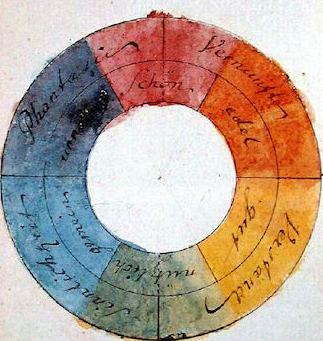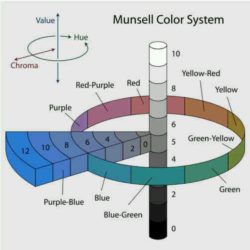Color Theory
Home > Color Theory
Color Theory
 Isaac Newton
Isaac Newton
Our modern understanding of color theory begins with Sir Isaac Newton (1642-1726). He was the first to understand the rainbow. Newton set up a prism near his window, and projected a beautiful spectrum of 7 “component” colors: red, orange, yellow, green, blue, indigo and violet. In order to prove that the prism was not just “coloring” the light, he refracted the light back together, resulting in a beam of “white” light.
Isaac Newton developed the first circular diagram of colors in 1666. Artists were fascinated by Newton’s clear demonstration that light alone was responsible for color. His most useful idea for artists was his conceptual arrangement of colors around the circumference of a circle. This allowed the painters’ primaries (red, yellow, blue) to be arranged opposite their complementary colors (e.g. red opposite green), as a way of denoting that each complementary color would enhance the other’s effect through optical contrast.
Since 1666, scientists and artists have studied and designed numerous variations of this concept.
Johann Wolfgang Goethe
 Until Johann Wolfgang Goethe (1749-1832) came along, no one had questioned the validity of Newton’s ideas about light and color. Johann Wolfgang Goethe sought a system to govern the use of color in art. At first he intended to create a new color wheel. But he found that creating a so called “equilateral triangle” was better suited to representing his emerging theories. While Newton’s system was based on scientific observation of additive color mixing, Goethe’s method was more conceptual, based on the psychological effects of color. He studied complementary colors, the colors of shadows, and after-images.
Until Johann Wolfgang Goethe (1749-1832) came along, no one had questioned the validity of Newton’s ideas about light and color. Johann Wolfgang Goethe sought a system to govern the use of color in art. At first he intended to create a new color wheel. But he found that creating a so called “equilateral triangle” was better suited to representing his emerging theories. While Newton’s system was based on scientific observation of additive color mixing, Goethe’s method was more conceptual, based on the psychological effects of color. He studied complementary colors, the colors of shadows, and after-images.
Goethe reformulated the topic of color in an entirely new way. Newton had viewed color as a physical problem, involving light striking objects and entering our eyes. Goethe realized that the sensations of color reaching our brain are also shaped by our perception, by the mechanics of human vision and by the way our brain processes information. Therefore, according to Goethe, what we see of an object depends upon the lighting, the object and our perception.
Johannes Itten
Founder of the 4-season color theory
 The next major set of theories comes from the Bauhaus, the highly influential German art and design school (1919-1933). The Bauhaus focused on the integration of art and industry. Bauhaus member Johannes Itten (1888-1967) was a Swiss color and art theorist who developed color charts and modified the color wheel. Itten’s color wheel is based on a primary triad of red, yellow and blue and includes 12 hues. Following Goethe’s lead Itten delved into the psychological and spiritual aspects of color. Itten was absorbed by the work of the old masters and he was also a vital participant in modern art movements.
The next major set of theories comes from the Bauhaus, the highly influential German art and design school (1919-1933). The Bauhaus focused on the integration of art and industry. Bauhaus member Johannes Itten (1888-1967) was a Swiss color and art theorist who developed color charts and modified the color wheel. Itten’s color wheel is based on a primary triad of red, yellow and blue and includes 12 hues. Following Goethe’s lead Itten delved into the psychological and spiritual aspects of color. Itten was absorbed by the work of the old masters and he was also a vital participant in modern art movements.
Itten has been the first to associate color pallets with four types of people. His concept began by splitting colors into 2 sections: WARM (yellow based) and COOL (blue based). These were then divided again into LIGHT or DARK. The result was 4 harmonized groups of colors which he called after the 4 seasons of the year. (spring = warm + light, autumn = warm + dark, summer = cool + light, winter = cool = dark). He noticed that the different seasonal color pallets enhanced the quality of his paintings by choosing background colors that match the faces on his portraits. Needless to say that his work gave inspiration to the creation of the 4 season color analysis theory.
Albert H. Munsell
Founder of the 12-season color theory
 Around 1905 the American artist and teacher Albert H. Munsell (1858-1918), created a new color model. Munsell was inspired by the work of fellow American and German painters to develop the first color model that systematically illustrates colors in three-dimensional space. His color model demonstrates relationships between full-spectrum hues (color families) as well as tints (value) and shades (chroma).
Around 1905 the American artist and teacher Albert H. Munsell (1858-1918), created a new color model. Munsell was inspired by the work of fellow American and German painters to develop the first color model that systematically illustrates colors in three-dimensional space. His color model demonstrates relationships between full-spectrum hues (color families) as well as tints (value) and shades (chroma).
Munsell’s most important realisation was that, when pure, some hues are more saturated (chroma) than others. With this new model Munsell was the first to develop a color theory that brought clarity to color communication. Before Munsell, colors were only described by words. Munsell succeeded in giving every color a unique number depending on where a color fitted in his new tri-dimensional color model. Munsell’s color model gave birth to the 12 season color analysis theory in the late 20th century. His system is more detailed and accurate than all the color models that ever existed.
Subscribe To My Blog
